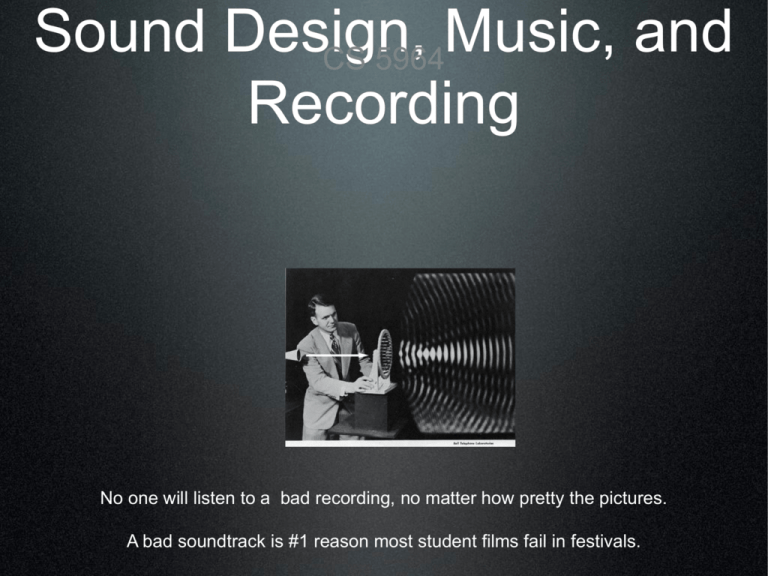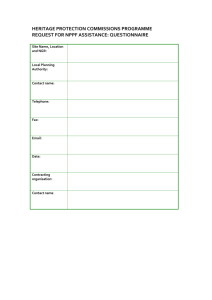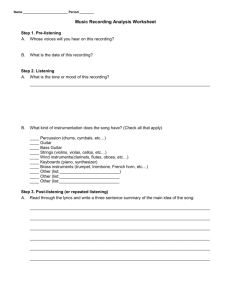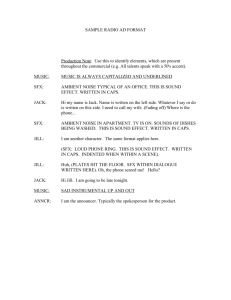CS5964Machinima_Sound_07
advertisement

Sound Design, Music, and CS 5964 Recording No one will listen to a bad recording, no matter how pretty the pictures. A bad soundtrack is #1 reason most student films fail in festivals. Sound Philosophy • Sound affects everything, changes the viewing experience • The other half (the better half?); Some say sound is 60% of the experience • Another dimension and aspect of storytelling (The Wrestler) • Sets emotional tone • Sound designer or director of sound (DS) position 2 Philosophies 1.) Complimentary/Reinforces • Aims for realism • Music fits the mood--Star Wars, Gone With the Wind, Top Gun, Gladiator--Howard Shore, John Williams; Wagner’s “Flight of the Valkyries” in Apocalypse Now • Sound effects reflect the ‘reality’ of the film • We hear what we expect... more emotional, more comfortable? 2 Philosophies 2.) Impressionistic/Ironic/Contrasts • More expressionistic • Music works in counterpoint (contrapuntal) to the image, adding another dimension: Dr. Strangelove (opening and closing sequences), Beethoven’s funeral march rather than Brahms’ wedding to actual wedding scene • Sound effects vary from perceived reality-exaggerate or replace the actual sound (Moulin Rouge, cartoons--Mickey Mousing) • We are ‘unsettled’ by the conflict of sound and image... more intellectual, stimulating? Diegetic vs. Non-Diegetic • Diegetic is sound that is motivated by and exists within the scene; source is visible • Dialogue of characters; Sound of objects in scene; Music from band or radio • Ex.--Apocalypse Now: radio starts as diegetic source and gradually switches to non-diegetic • Broken Flowers • Non-Diegetic does not exist within the scene and is not visible • Voice-Over/Narration • Sound effects added for dramatic effect • Music • Most music is non-diegetic Elements of a Soundtrack 1.) Voice • Dialog • Interview • Narration (voice-over) QuickTime™ and a decompressor are needed to see this picture. Live Sound Only (recorded on set) Elements of a Soundtrack 2.) Sound Effects (SFX) • Live recording on set • Foley in studio (also known as men in tights) • Lots of free SFX/music online: • www.soundsnap.com • www.sonomic.com QuickTime™ and a decompressor are needed to see this picture. Live Sound & Sound FX Elements of a Soundtrack 3.) Music • Music for movie vs. Movie for music (music video) • Iconic music (well-known tunes hazardous and can take over your piece) • Pre-Recorded: Classical, Jazz, Rock/Pop; Regional, etc... • Composed (specifically for film) • Lots of free SFX/music online: • www.jamendo.com QuickTime™ and a decompressor are needed to see this picture. Complete Soundtrack with Music CHARACTERISTICS • Amplitude or loudness • Wavelength--distance from one crest to another • Frequency--rate at which the waves pass a given point • Pitch--the higher the frequency becomes, the higher the pitch we hear CHARACTERISTICS • Human ear can normally hear sounds in the 20 Hz to 20,000 Hz (20 kHz) range • 20 Hz--lowest hum or rumble our ears can detect • 20 kHz--highest pitch perfectly good ears can hear Sound Recording Equipment • Most microphones you will encounter are omnidirectional • Omni-directional • pick up sound equally from all directions • designed to be used in close range • don’t pick up too much background noise Sound Recording Equipment • Other mic options Sound Recording Equipment • From analog tape to digital recorders • Tapes have an inherent ‘sound’ that came with the material • Digital tends to be quieter and cleaner (though some prefer analog) Recording Sound • Signal to noise ratio • Distant from mic vs. close to mic audio waveform patterns • Ambient noise patterns Thin • 3 ways to get better sound • Move mic closer to source (45˚ angle to avoid pop) Good • Record in a quiet place, or a place appropriate for the sound • Record ambient Sound and lay it on a separate track Thick Recording Sound • Stop and listen to your environment • Every place has it’s own ambient sound, or background noise • Try to eliminate ‘noise’ from things like heating/cooling systems, computers, refrigerators, the television in the next room, traffic, etc... • Record all dialog in the same place so ambient is the same • Record at least 30 sec. of ambient that can be looped • Wear headphones to hear what’s recorded!!! Live “Recording” – 30 secs. of room tone Why they say “quiet on the set” Recording Sound • Watch your meters to be sure your level is not too high or too low • Get a nice solid level so you don’t have to amplify in the software Peak meter (for digital) • Good levels top around the -12 (green) to 6 (yellow) on a peak meter • Peaking in the red should be avoided VU Meter (for analog) Manipulation & Post • Built-in effects • EQ • Reverb • Speed changes • Chip and Dale • Slow mo • Adjust levels for voice • Mixing sound • Last thing you do for a film, is watch the meters Peak meter (for digital) Organizing Tracks V1 A1 A2 A3 A4 A5 A6 Video Dialogue--1st character Dialogue--2nd character Sound FX Sound FX Ambient Music Dip levels for music during dialog CLOSING WORDS • Microphones don’t have a brain; you have to do the thinking for them • Sound is a completely different storytelling device; use it to tell your story • Don’t just throw Top Gun music to every jet plane scene you have, or the latest pop ballad to every love scene; think about what the music does for the piece







